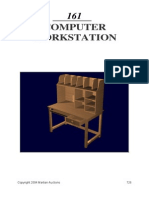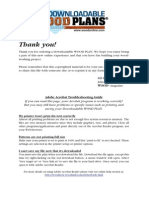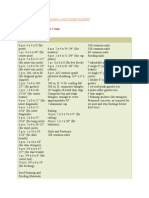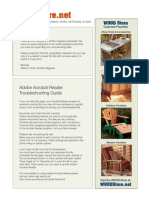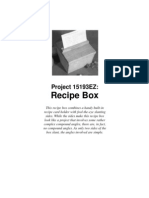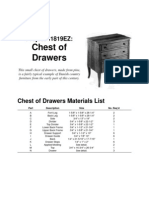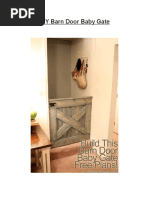0 ratings0% found this document useful (0 votes)
32 viewsThe Turned Hall Tree: A Great Weekend Project To Help Build Your Woodturning Skills
The Turned Hall Tree: A Great Weekend Project To Help Build Your Woodturning Skills
Uploaded by
SergeiThis document provides instructions for building a turned hall tree project to improve woodturning skills. The project uses common lumber and requires turning dowels and spindles of various sizes that assemble together. The spindles are tapered and have holes drilled at angles to accept coat pegs or dowels for joining the legs. Simple instructions are provided on cutting, shaping, sanding, and assembling the wood pieces with glue to create a hall tree that can function as additional storage and fit various decor styles.
Copyright:
© All Rights Reserved
Available Formats
Download as PDF, TXT or read online from Scribd
The Turned Hall Tree: A Great Weekend Project To Help Build Your Woodturning Skills
The Turned Hall Tree: A Great Weekend Project To Help Build Your Woodturning Skills
Uploaded by
Sergei0 ratings0% found this document useful (0 votes)
32 views2 pagesThis document provides instructions for building a turned hall tree project to improve woodturning skills. The project uses common lumber and requires turning dowels and spindles of various sizes that assemble together. The spindles are tapered and have holes drilled at angles to accept coat pegs or dowels for joining the legs. Simple instructions are provided on cutting, shaping, sanding, and assembling the wood pieces with glue to create a hall tree that can function as additional storage and fit various decor styles.
Original Description:
Вешалка напольная
Original Title
Вешалка напольная
Copyright
© © All Rights Reserved
Available Formats
PDF, TXT or read online from Scribd
Share this document
Did you find this document useful?
Is this content inappropriate?
This document provides instructions for building a turned hall tree project to improve woodturning skills. The project uses common lumber and requires turning dowels and spindles of various sizes that assemble together. The spindles are tapered and have holes drilled at angles to accept coat pegs or dowels for joining the legs. Simple instructions are provided on cutting, shaping, sanding, and assembling the wood pieces with glue to create a hall tree that can function as additional storage and fit various decor styles.
Copyright:
© All Rights Reserved
Available Formats
Download as PDF, TXT or read online from Scribd
Download as pdf or txt
0 ratings0% found this document useful (0 votes)
32 views2 pagesThe Turned Hall Tree: A Great Weekend Project To Help Build Your Woodturning Skills
The Turned Hall Tree: A Great Weekend Project To Help Build Your Woodturning Skills
Uploaded by
SergeiThis document provides instructions for building a turned hall tree project to improve woodturning skills. The project uses common lumber and requires turning dowels and spindles of various sizes that assemble together. The spindles are tapered and have holes drilled at angles to accept coat pegs or dowels for joining the legs. Simple instructions are provided on cutting, shaping, sanding, and assembling the wood pieces with glue to create a hall tree that can function as additional storage and fit various decor styles.
Copyright:
© All Rights Reserved
Available Formats
Download as PDF, TXT or read online from Scribd
Download as pdf or txt
You are on page 1of 2
The Turned Hall Tree
A great weekend project to help build your woodturning skills
Here’s a relatively simple project that doubles in function and
beauty. Build it this weekend and you’ll soon have additional “closet
space” – PLUS – a classic, traditionally-designed “piece of furniture” that
blends well with practically any decorating scheme.
All you’ll need are one 4” x 4” x 8’ and one 2” x 4” x 6’ pieces of
lumber plus eight dowel pins and two double-ended dowel screws. That’s
it! We used redwood for its natural rich color and ease of turning....but
any soft, easily-turned hardwood will work equally well.
First, decide on your design. Ours is pretty traditional and you
should have little difficulty duplicating it by following the drawing. You could try a straight tapered
pencil-post design with a Shaker flair...or a more contemporary design. The choice is yours.
Start the building process by cutting your 4” x 4” stock to length, being sure to allow an extra
1/2" on each end. Separately turn and finish sand (while on the lathe), each of the three main spindle
parts (A, B, and C).
Next, resaw some 4” x 4” scrap into1-1/8” square pieces 12” long for the six coat pegs (E).
These can be most efficiently turned end-to-end, two at a time, from a single length of stock.
TIP: For added efficiency and a dead-on match, use Shopsmith’s Lathe Duplicator.
Now, lay out the legs (D) on your 2” x 4” stock.. Start by cutting the angle for the leg tops.
Drill the 3/8” dowel peg holes using the MARK V’s Horizontal Boring Mode. Be sure to set up some
stops so all (8) holes are drilled in the exact same relative position.
Use your Bandsaw to cut out your four legs. At this point, you can either round-over all leg
edges using your Belt Sander or an inflatable, Contour Sanding Drum...or you can create more
intricately shaped edges using a Router set-up, or a Shaper and the cutter profiles of your choice.
Next, set up your MARK V in Drill Press mode and bore the (8) 3/8” holes in the Bottom
Spindle (C) for the Leg dowel pegs. Be sure to measure and mark the positions of these holes accu-
rately, so they line up precisely with the mating holes in each Leg end.
The tapered Top Spindle (A) has six equally positioned holes that divide the spindle into three
equal sections. Here’s how to do this: Wrap a piece of paper around the turned Spindle (A) and mark
the diameter of the Top. Flatten the paper out, measure the diameter and divide it into three equal
sections. Transfer these marks onto your turned Spindle.
With your MARK V Worktable tilted to 30-degrees, use a shop-made V-Block jig to hold the
Spindle while you drill the angled Coat Peg holes with a Forstner Bit. See Figure 1.
Prior to final assembly, drill 1-1/4” deep x 3/16” dia. pilot holes into the bottom of Spindle
(A), both ends of Spindle (B) and the top of Spindle (C). These holes are for the Dowel Screws (G).
Apply a small amount of soap, beeswax, paste wax, or paraffin to both ends of the Dowel
Screws and “test-assemble” the three-part Spindle. Take the Spindle apart and remove all traces of
soap, beeswax, paste wax, or paraffin squeeze-out.
Apply ample glue to the end grains of all Spindles where they will join together...tighten them
down...remove any glue squeeze-out and allow to dry overnight.
Finally, glue and dowel the Legs (D) and the Pegs (E) to the assembled Spindle and allow to
dry for 24 hours before applying the finish of your choice.
List of Materials
(finished dimensions in inches)
A: Top Spindle 2-1/2 dia. x 13-3/4
B: Middle Spindle 3-1/4 dia. x 33
C: Bottom Spindle 3-3/8 dia x 14
D: Legs (3) 1-1/2 x 3-1/2 x 14
E: Pegs (3) 1 dia. x 6
Pegs (3) 1 dia. x 5
F: Dowel Pegs (8) 3/8 dia. x 2
G: Dowel Screws (2) 5/16 dia. x 2-1/2
You might also like
- CanoePlansPart1 PDFDocument20 pagesCanoePlansPart1 PDFcockybundoo83% (6)
- Mobile WorkbenchDocument5 pagesMobile Workbenchcfh666100% (3)
- Adirondack Chair Plans 10pagesDocument10 pagesAdirondack Chair Plans 10pagesNilton100% (2)
- Phone Holder Front LoaderDocument22 pagesPhone Holder Front LoaderSergei100% (2)
- Tilting Mirror Stand - FH96DJADocument7 pagesTilting Mirror Stand - FH96DJAJvlValenzuelaNo ratings yet
- Small Colonial Bench: Project 10297EZDocument5 pagesSmall Colonial Bench: Project 10297EZmhein68No ratings yet
- Stacking Desk Tray: Project 19874EZDocument4 pagesStacking Desk Tray: Project 19874EZBSulliNo ratings yet
- Table - 16 Drawer Apothecary PDFDocument2 pagesTable - 16 Drawer Apothecary PDFmmylito0% (1)
- EZPicnic TableDocument7 pagesEZPicnic TableBSulliNo ratings yet
- WJ099 Picnic Table PDFDocument0 pagesWJ099 Picnic Table PDFCarlos A. Mendel100% (1)
- Computer WorkstationDocument8 pagesComputer Workstation- yAy3e -100% (1)
- DP 00011Document14 pagesDP 00011Jason Weber100% (1)
- Major ProjectDocument5 pagesMajor ProjectGary LavoieNo ratings yet
- Porch Swing: Project 16258EZDocument5 pagesPorch Swing: Project 16258EZBSulli100% (1)
- Traditional Bookcase: Woodworks: Intermediate ProjectDocument6 pagesTraditional Bookcase: Woodworks: Intermediate ProjectDúctil De La Gran Raza de YithNo ratings yet
- Tools and Materials:: Rojects Online: Building A Six-Sided GazeboDocument8 pagesTools and Materials:: Rojects Online: Building A Six-Sided GazeboMara_Traistaru_808No ratings yet
- Cedar Patio TableDocument8 pagesCedar Patio TableJohn RyanNo ratings yet
- Planter Box PlanDocument9 pagesPlanter Box PlanGsmHelp100% (2)
- Country Curio Clock: Project 12231EZDocument7 pagesCountry Curio Clock: Project 12231EZBSulliNo ratings yet
- How To Make A Cornhole BoardDocument4 pagesHow To Make A Cornhole BoardAndré VeigaNo ratings yet
- Coffe TableDocument15 pagesCoffe TableJun Vargas100% (1)
- Woodworking Plans - Workbench - Popular Mechanics - Hard MapleDocument7 pagesWoodworking Plans - Workbench - Popular Mechanics - Hard Maplepandearroz100% (2)
- Mesa China CarpinteriaDocument7 pagesMesa China CarpinteriaMCarrillo_1971No ratings yet
- Minwax Advanced Project Adirondack ChairDocument9 pagesMinwax Advanced Project Adirondack ChairPetrus Cassu Menck100% (2)
- Mesa de JardinDocument5 pagesMesa de JardinDisho1934No ratings yet
- Table Saw Cabinet PDFDocument11 pagesTable Saw Cabinet PDFEd Bozman100% (1)
- ParquetDocument4 pagesParquetFernando FrayreNo ratings yet
- Wood Working Plans - Toys - Rocking Horse PDFDocument6 pagesWood Working Plans - Toys - Rocking Horse PDFBen GerezNo ratings yet
- Arched Aurora NightstandDocument7 pagesArched Aurora NightstandRoberto LandaNo ratings yet
- Bench - Classic Cedar Garden PDFDocument11 pagesBench - Classic Cedar Garden PDFmarianrkwNo ratings yet
- Cardboard Geodesic DomeDocument5 pagesCardboard Geodesic DomeJuan Burgaya100% (1)
- Ultimate WorkbenchDocument8 pagesUltimate WorkbenchEric Gruff0% (1)
- Kreg Multipurpose Work CenterDocument14 pagesKreg Multipurpose Work CenterMiguel Angel Garcia de la Rosa100% (1)
- Recipe Box: Project 15193EZDocument5 pagesRecipe Box: Project 15193EZBSulli100% (1)
- Cherry Dresser: How To Build A Classic 5-Drawer DresserDocument9 pagesCherry Dresser: How To Build A Classic 5-Drawer DresserriverbendfcNo ratings yet
- Honey Super Plans FreeDocument6 pagesHoney Super Plans FreeMATHIXNo ratings yet
- David de Lossy/Photodisc/Getty ImagesDocument15 pagesDavid de Lossy/Photodisc/Getty ImagesasiasiNo ratings yet
- Craftsman End Table 2Document9 pagesCraftsman End Table 2Muns Badilla100% (1)
- 2 - Woodworking Plans - OakplateDocument6 pages2 - Woodworking Plans - OakplatemacpatorNo ratings yet
- Rocking Horse Project - LowesDocument3 pagesRocking Horse Project - Lowescrm102bNo ratings yet
- Woodworks - 103-Blanket ChestDocument10 pagesWoodworks - 103-Blanket ChestzdejotaNo ratings yet
- Kreg Tool - Innovative Solutions For All of Your Woodworking and DIY Project NeedsDocument7 pagesKreg Tool - Innovative Solutions For All of Your Woodworking and DIY Project NeedsP. MNo ratings yet
- Wj001 Barristers BookcaseDocument7 pagesWj001 Barristers BookcasemiclarkNo ratings yet
- Chest of Drawers: Project 11819EZDocument7 pagesChest of Drawers: Project 11819EZBSulli100% (1)
- Barn Door Baby GateDocument17 pagesBarn Door Baby GateNovitates1No ratings yet
- WJ140 Hoosier Step StoolDocument7 pagesWJ140 Hoosier Step Stoolmtejadacoll100% (1)
- 021Document30 pages021sergio100% (6)
- DIY Barn Door Baby GateDocument17 pagesDIY Barn Door Baby GateJessicaMaskerNo ratings yet
- Children's Bunkhouse LoftDocument7 pagesChildren's Bunkhouse Loft- yAy3e -100% (3)
- Cardboard Geodesic DomeDocument5 pagesCardboard Geodesic DomeJuan BurgayaNo ratings yet
- Wooden BookcaseDocument6 pagesWooden BookcaseCris CondeNo ratings yet
- Construir Uma Guitarra Elétrica - Sem As Ferramentas de FantasiaDocument15 pagesConstruir Uma Guitarra Elétrica - Sem As Ferramentas de FantasiaTradulineNo ratings yet
- Timber Frame Bird House InstructionsDocument8 pagesTimber Frame Bird House InstructionsBobNo ratings yet
- WJ088 Garden BenchDocument13 pagesWJ088 Garden BenchOsvaldo Moraes100% (1)
- Tapered PlanterDocument3 pagesTapered Planter- yAy3e -100% (1)
- Project Plans: Tool Storage CenterDocument14 pagesProject Plans: Tool Storage CenterJayme LealNo ratings yet
- PP DoubledeskDocument3 pagesPP DoubledeskLadySerasNo ratings yet
- Simple Elegance: A Table With Few Parts and Uncomplicated Joinery Proves That Less Is MoreDocument5 pagesSimple Elegance: A Table With Few Parts and Uncomplicated Joinery Proves That Less Is Moreanca mariaNo ratings yet
- Family Handyman Ultimate 1 Day ProjectsFrom EverandFamily Handyman Ultimate 1 Day ProjectsRating: 5 out of 5 stars5/5 (1)
- Build Your Own Six-Seater Picnic Table: Using 2 x 4 (50 x 100 mm) Lumber, #1From EverandBuild Your Own Six-Seater Picnic Table: Using 2 x 4 (50 x 100 mm) Lumber, #1No ratings yet
- Ultimate Quilt Block Collection: The Step-by-Step Guide to More Than 70 Unique Blocks for Creating Hundreds of Quilt ProjectsFrom EverandUltimate Quilt Block Collection: The Step-by-Step Guide to More Than 70 Unique Blocks for Creating Hundreds of Quilt ProjectsRating: 5 out of 5 stars5/5 (1)
- Wood Toy Car 170127aDocument6 pagesWood Toy Car 170127aSergeiNo ratings yet
- Cevrolet: @2019 @danehsekaliDocument8 pagesCevrolet: @2019 @danehsekaliSergeiNo ratings yet
- Austin Mini: Full-Size Wood ToyDocument8 pagesAustin Mini: Full-Size Wood ToySergei100% (2)
- Jeep PuzzleDocument3 pagesJeep PuzzleSergeiNo ratings yet
- Fighter Plane: Finished Puzzle Size 1" Thick X 6-7/16" Tall X 10-1/2" WideDocument3 pagesFighter Plane: Finished Puzzle Size 1" Thick X 6-7/16" Tall X 10-1/2" WideSergeiNo ratings yet
- New Age PlaypalsDocument11 pagesNew Age PlaypalsSergeiNo ratings yet
- Toy Racing Car PlansDocument2 pagesToy Racing Car PlansSergei100% (1)
- Wooden Car DesignsDocument3 pagesWooden Car DesignsSergei100% (1)
- Rocking Airplane Kids ToyDocument34 pagesRocking Airplane Kids ToySergei100% (1)
- Army Tank: Finished Puzzle Size 1" Thick X 6-7/16" Tall X 10-1/2" WideDocument3 pagesArmy Tank: Finished Puzzle Size 1" Thick X 6-7/16" Tall X 10-1/2" WideSergeiNo ratings yet
- Truck: Full-Size Wood ToyDocument8 pagesTruck: Full-Size Wood ToySergeiNo ratings yet
- Wooden Bus Kids Toy PlanDocument9 pagesWooden Bus Kids Toy PlanSergeiNo ratings yet
- Truck: Full-Size Wood ToyDocument8 pagesTruck: Full-Size Wood ToySergeiNo ratings yet
- Dinasti ShangDocument2 pagesDinasti ShangAfiqh RahadyanNo ratings yet
- Clasification of AmplifiersDocument20 pagesClasification of Amplifiersvaishnavi1994No ratings yet
- Revised Thesis TopicDocument14 pagesRevised Thesis Topicdhannukhan95No ratings yet
- Name - Date: - ScoreDocument4 pagesName - Date: - ScoreAlcel Grace AsuqueNo ratings yet
- Andal Doctrine - Psychological IncapacityDocument2 pagesAndal Doctrine - Psychological IncapacityDonna Dumaliang0% (1)
- Necrotizing Ulcerative GingivititisDocument9 pagesNecrotizing Ulcerative GingivititisSaja SajoNo ratings yet
- Courtesy Costs Nothing But Buys EverythingDocument3 pagesCourtesy Costs Nothing But Buys EverythingNurul HusnaNo ratings yet
- Toyota Forklift 8fbm20t to 8fbm35t 8fbmk25t 8fbmk30t Repair ManualDocument24 pagesToyota Forklift 8fbm20t to 8fbm35t 8fbmk25t 8fbmk30t Repair ManualyoustroyerrhNo ratings yet
- A Comprehensive Survey On Transfer LearningDocument31 pagesA Comprehensive Survey On Transfer LearningŞems KurtoğluNo ratings yet
- 300 Fcps Mcq's SolvedDocument16 pages300 Fcps Mcq's SolvedFarazNo ratings yet
- Bohr Diagram LessonDocument26 pagesBohr Diagram LessonGlenn ClementeNo ratings yet
- A Briefer History of Time by Eric SchulmanDocument144 pagesA Briefer History of Time by Eric SchulmanbuenanuevaNo ratings yet
- Jan 2017Document16 pagesJan 2017saraNo ratings yet
- 0539 s19 QP 1-MergedDocument96 pages0539 s19 QP 1-MergedshujaitbukhariNo ratings yet
- Complete NANDandJTAG TutorialDocument7 pagesComplete NANDandJTAG TutorialBrian HussNo ratings yet
- GeoTech - 43-2913 - Residential Development - Avenue LDocument27 pagesGeoTech - 43-2913 - Residential Development - Avenue Lhunain shoukatNo ratings yet
- Bear Guilty of Stealing Honey Reading Comprehension Exercises - 14882Document4 pagesBear Guilty of Stealing Honey Reading Comprehension Exercises - 14882Anna RovytskaNo ratings yet
- Win in Thinking SkillsDocument77 pagesWin in Thinking SkillsBai Li100% (1)
- Action Plan For MTDocument15 pagesAction Plan For MTCACHOLA RAMOSNo ratings yet
- Lesson Plan For SetsDocument9 pagesLesson Plan For SetsNorce LynNo ratings yet
- Ch2 ConceptDocument164 pagesCh2 ConceptChristian Laguio100% (2)
- Benjamin Franklin: Early CareerDocument2 pagesBenjamin Franklin: Early CareerJoelNo ratings yet
- Draft India - DCS - NationalStudy - Peer Review FinalDocument65 pagesDraft India - DCS - NationalStudy - Peer Review FinalVikram MurthyNo ratings yet
- SDS - PentoMag 4410 - 10036 - E - Rev 1-2 - 210226Document11 pagesSDS - PentoMag 4410 - 10036 - E - Rev 1-2 - 210226mtalha9507No ratings yet
- Da68-04023j-02 Manual Users en Mes CFR Rf9000a F-HubDocument248 pagesDa68-04023j-02 Manual Users en Mes CFR Rf9000a F-HubNeal JarmuskeNo ratings yet
- Exoplanets Expansion ENGDocument6 pagesExoplanets Expansion ENGHerken44No ratings yet
- NiceguyDocument14 pagesNiceguyCatherine RodeoNo ratings yet
- ArtistsNetwork DrawingSketches2 PARTEDocument13 pagesArtistsNetwork DrawingSketches2 PARTEFernando GarciaNo ratings yet
- Pr2 KenemeDocument4 pagesPr2 KenemePoblete RexNo ratings yet
- Aieee 2006 PaperDocument21 pagesAieee 2006 PaperjanmanchiNo ratings yet










